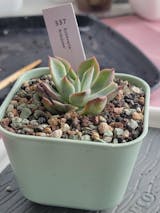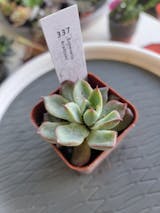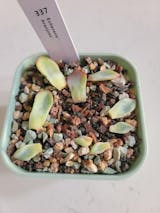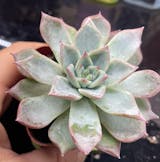About Echeveria 'Aranjuez'
The Echeveria 'Aranjuez' is a succulent plant that belongs to the Crassulacea family and is part of the Echeveria genus. This plant has plump leaves that form a lovely rosette and can come in shades of pink, dark red, or dark purple. As it thrives, its leaves may turn red or even black. When in optimal condition, the Echeveria 'Aranjuez' will have a transparent appearance, and its red leaves and diamond-like patterns will resemble intricate carvings in red crystal.
How to care for Echeveria 'Aranjuez'
Sun: The color of Echeveria 'Aranjuez' is not something that happens overnight. It is a gradual process that needs the right conditions. Adequate exposure to light is crucial for this plant to thrive and develop short, thick leaves, as well as achieve a compact form. Providing ample sunlight during the fall and winter is important to speed up the coloration process. However, during the hot summer, it is important to protect the plant from direct sunlight or limit its exposure to light to prevent sun damage to the leaves.
Temperature: Echeverias are a type of succulent that enjoys temperatures between 65°F and 70°F. Exposure to temperatures under 50°F could potentially cause harm. These plants can grow outside in USDA zones 9 and 10, but for other areas, it is best to keep them as houseplants during the colder months and slowly transition them outdoors once the risk of frost has diminished.
Soil/Watering: Echeveria 'Aranjuez' is a succulent that can endure drought but not waterlogging. So using the Organic Succulent and Cactus Soil Mix is a good option, about 60%-80% of particles, which allows the water to drain as quickly as possible without accumulating in the pot. It is crucial to avoid over-watering and to keep the potting soil slightly moist and dry for the plant's well-being. Inadequate care can lead to problems with the root system, which can cause conditions such as clear leaves and black rotting of the stem. The suggestion is only to provide water to the plant after the soil has become entirely dry.
Propagation: Take a closer look at the plant's thick leaves, which are most likely ideal for leaf propagation. Delicately shake off the fully grown leaves from the lower part of the plant. Then, put them in a dry and well-ventilated location for a few days until the wound is callous. Once healed, lay the leaves flat on the soil and allow the roots to grow. For additional information on propagation, click here.
More information
Primary color: Pink, dark red, or dark purpleSecondary color: GreenCold hardiness: USDA zones 9-10Product format: rooted in 2" nursery pot.Suitability: balcony, windowPropagation: leaf, behead






